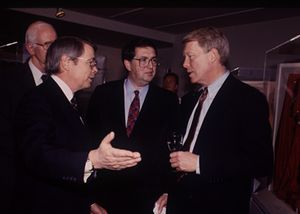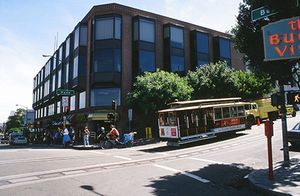In the previous installment, the formation of the American Academy of Ophthalmology as a separate entity, the expansion of its mission and its clarification of governance all occurred while Dr. Bruce E. Spivey was its executive vice president.
The transition to the leadership of H. Dunbar Hoskins Jr., MD, as executive vice president occurred in 1993, with new challenges and new directions consequent to both internal as well as external sources.
In searching for the new EVP, the Academy board underwent a membership-wide search. This choice was all the easier because Dr. Hoskins was a known quantity in the Academy’s interests. He chaired the media committee, served as secretary for instruction, secretary for the annual meeting, chair of the long-range planning group and, in a life outside of the Academy, was active in the Pan-American Association of Ophthalmology.
Dr. Hoskins served as chair of the board of a hospital which provided a major turnaround to that organization. He was also active in the speaking circuit, so he was well-known among academic departments. In short, he had experience in organizational management, was fully vetted in the Academy, served as a communicator with business savvy and valued the educational basis of the Academy’s existence. On top of all this, he was a Southern gentleman who lived 17 miles away from the offices of the Academy.

H. Dunbar Hoskins, Jr., MD, Academy EVP, 1993 - 2009. Pictured with former US Representative, Dick Gephardt.
One of Dr. Hoskins’ early conclusions was that the breadth of the Academy’s activities was such that the right and the left hand were occasionally at conflict in interests and messaging. Using the reorganization report, he initially created four divisions: advocacy, education, ophthalmic practice and organizational services. He later added divisions for membership and the annual meeting.
At the staff level, each division was assigned a vice president, and he quickly made it clear that at the vice president level, Dr. Hoskins expected professional leadership with clearly defined goals and results. Included in those results was an informational flow across the organization, including physician leadership.
This organizational design plan suggested the inclusion of non-physician positions on the Board of Trustees. These board positions do not vote on clinical matters or dispositions of the Ethics Committee. As a matter of fact, they do not speak a great deal unless the board loses a big-picture focus on any issue. When they do speak, it has a big impact. You should know that this model has worked so well that other national medical organizations have included nonphysicians to their boards.
Shortly after his tenure began, Dr. Hoskins looked into the financial structure of the Academy’s building lease (the Academy was a tenant). We had an equity participation lease and learned that we had a lot of participation, but no equity. When he uncovered a shell game by the owner, Dr. Hoskins took him to court and purchased the building for $19 million. The current value of the building is estimated at more than $40 million.
In addition to securing ownership of this prime real estate, Dr. Hoskins was busy with other new projects:
The Mid-Year Forum allows the organization to report and assess issues more rapidly. The communication at this meeting serves as a great sounding board. The march on Capitol Hill provides a powerful voice for the profession and a training ground for younger members whose career are impacted by Washington, D.C. events.
By increasing resources to the office of Governmental Affairs, there was a radical revision of the D.C. office in this era. Cathy Cohen came home as vice president, and Dr. Bill Rich became medical director for Health Policy. The dark years of decline in Medicare coverage for cataract surgery finally stopped. Dr. Rich provided leadership with the Relative Value Update committee; even the American Medical Association told me he was superb.
When it came to planning, Dr. Hoskins recognized that the term “long-range planning” generally ended up becoming a “200-page doorstop” that everyone ignored. He saw that the basic problem with long-range planning is that it is out of date within two years. He clearly understood the importance of mission-values-goal-and functions, and he preferred to refine the planning process around proactive-reactive and resiliency.
Dr. Hoskins’ embrace of technology
Did you know that Dr. Hoskins was once involved in a computer company? Did you know that he could write code?
The first Academy computer was a word processor, and it was used to compile the Annual Meeting in 1983. In 1984, it found a home on the desk of the Annual Meeting director. It was the size of a Buick.

AAO Heardquarters in San Francisco, CA
Dr. Hoskins understood the power of computers as a partner in all of our lives. He recognized its value as an organizational management tool. We even explored the possibility of becoming a paperless association. But the complexities of the organization were too great.
When asked in 1997 if he thought that outcomes-data could be used to improve patient care, Dr. Hoskins said yes, but only if a functioning electronic medical record could be developed.
The power of the internet was so prominent in Dunbar’s thinking that he pressed to rename the news magazine to EyeNet as we began to establish a full Academy website. The first iteration of the site was very simple. It worked because we’d only begun to unlock its potential. It quickly changed as members and the public began to find the site a trusted source of membership information and support.
Dr. Hoskins’ real dream was to leverage the internet to encompass the educational format of the Academy and organized ophthalmology. He organized an effort to collate the immense resources of ophthalmology’s basic and clinical information to form what you know today as the ONE® Network.
The ONE Network is accessed from all over the world. Its content is derived from an international pallet of contributors. Other national and international societies are scrambling to follow the lead set by the ONE Network. It took bold imagination, a sizable amount of dollars, hours of time and broad collaboration, but Dr. Hoskins has changed the face of ophthalmic knowledge dissemination forever to the benefit of ophthalmologists and the patients they serve.
Finally, in my opinion the membership of the Academy has been blessed by broad inclusion in its programs and policies; by a board of trustees that develops direction as colleagues, not as combatants; by retaining executive vice presidents who invest the authority to get the job done. Those EVPs have evolved a culture within the Academy staff that allows for broad inclusion, freedom to criticize and a true partnership with the physician leadership.
I try to end each new staff member orientation with the statement that if they can go home every night having assisted just one ophthalmologist in the care of one patient, they should be proud of where they work. I know I am proud to have been included.